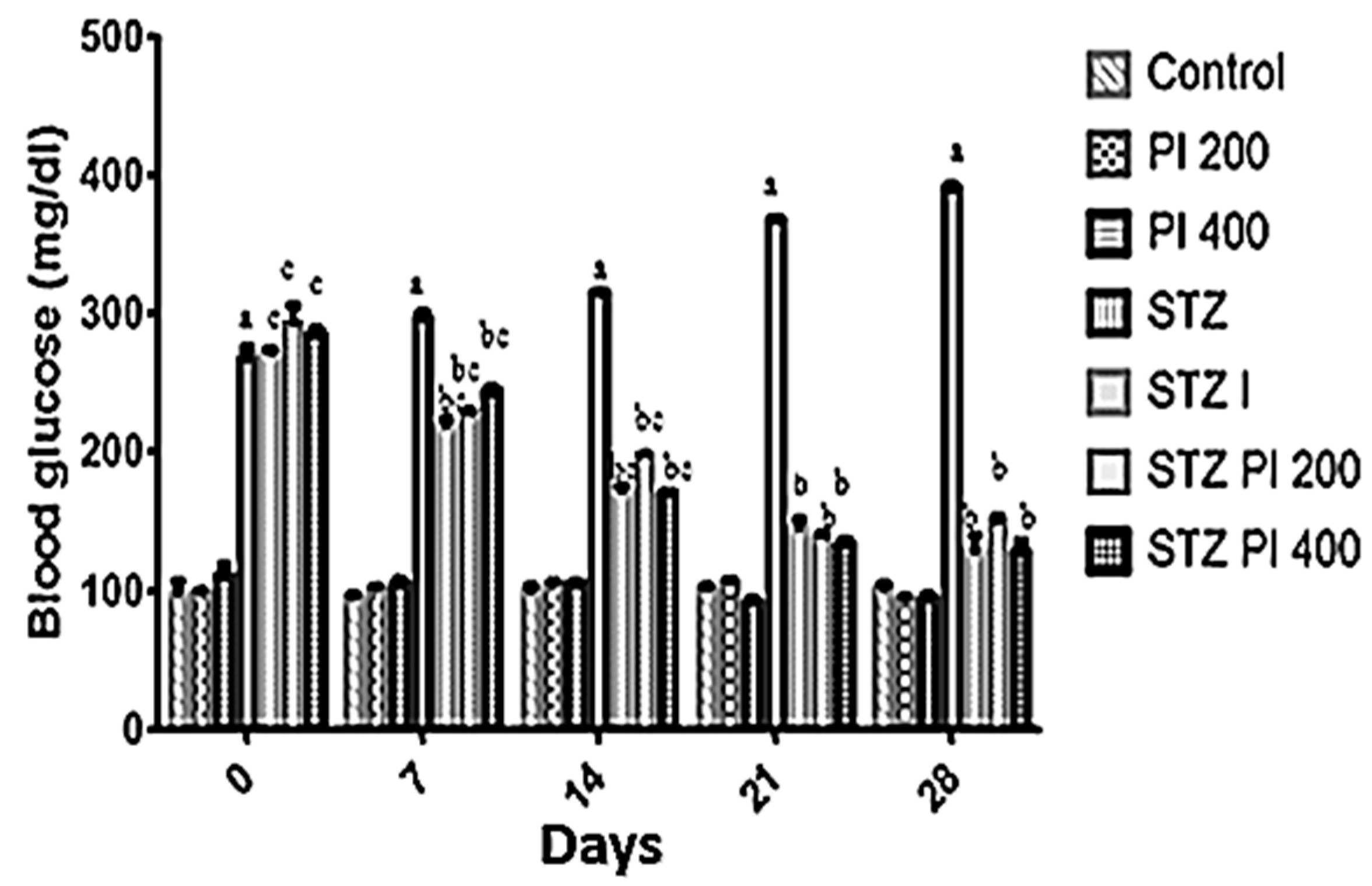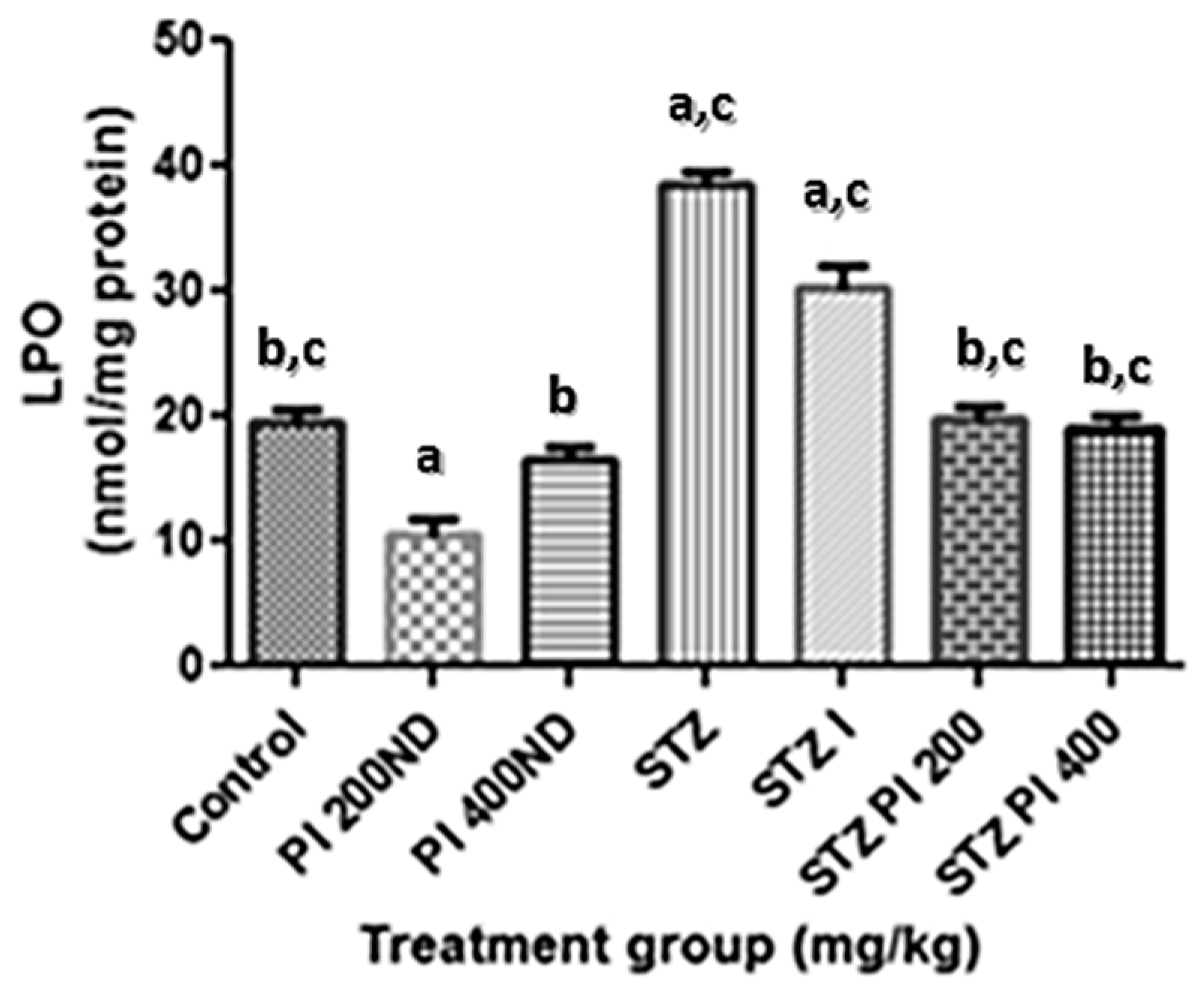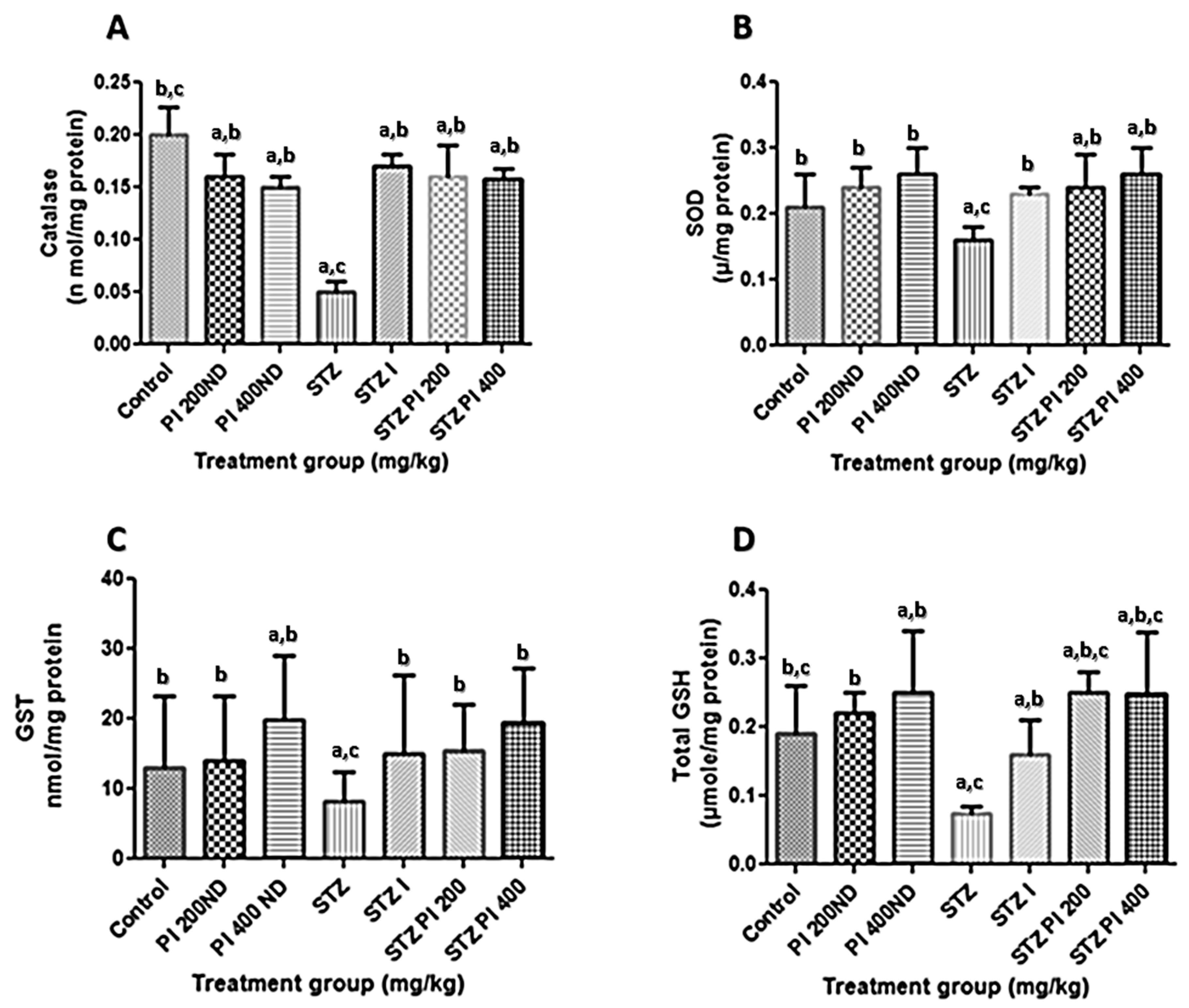Protein Isolate from Parkia biglobosa Seeds Improves Dyslipidaemia and Cardiac Oxidative Stress in Streptozotocin-Induced Diabetic Rats
Abstract
1. Introduction
2. Materials and Methods
2.1. Chemicals
2.2. Collection of Plant Materials
2.3. Preparation of the Protein Isolate
2.4. STZ-Induced Experimental Diabetic Rats and Experimental Design
2.5. Induction of Diabetes in Experimental Animals
2.6. Determination of Lipid Profile in Serum
2.7. Measurements of Antioxidants and Malondialdehyde Content
2.8. Statistical Analysis
3. Results
4. Discussion
5. Conclusions
Author Contributions
Funding
Conflicts of Interest
References
- Upasani, S.V.; Ingle, P.V.; Patil, P.H.; Nandedkar, R.Y.; Shah, V.S.; Surana, S.J. Traditional Indian spices useful in Diabetes Mellitus—An updated review. J. Pharm. BioSci 2013, 4, 157–161. [Google Scholar]
- Yan, B.; Ren, J.; Zhang, Q.; Gao, R.; Zhao, F.; Wu, J.; Yang, J. Antioxidative Effects of Natural Products on Diabetic Cardiomyopathy. J. Diabetes Res. 2017, 2017, 2070178. [Google Scholar] [CrossRef] [PubMed]
- Arora, S. Renal function in diabetic nephropathy. World J. Diabetes 2010, 1, 48–56. [Google Scholar]
- Kangralkar, V.A.; Shivraj, D.P.; Bandivadekar, R.M. Oxidative stress and diabetes: A review. Int. J. Pharm. Appl. 2010, 1, 38–45. [Google Scholar]
- Tangvarasittichai, S. Oxidative stress, insulin resistance, dyslipidemia and type 2 diabetes mellitus. World J. Diabetes 2015, 6, 456–480. [Google Scholar] [CrossRef]
- Sharma, M.; Fernandes, J.; Ahirwar, D.; Jain, R. Hypoglycemic and hypolipidimic activity of alcoholic extract of citrus aurantium in normal and alloxan-induced diabetic rats. Pharmacologyonline 2008, 3, 161–171. [Google Scholar]
- Özder, A. Lipid profile abnormalities seen in T2DM patients in primary healthcare in Turkey: A cross-sectional study. Lipids Health Dis. 2014, 13, 183. [Google Scholar] [CrossRef]
- Khadke, S.; Harke, S.; Ghadge, A.; Kulkarni, O.; Bhalerao, S.; Diwan, A.; Pankaj, M.; Kuvalekar, A. Association of fasting plasma glucose and serum lipids in Type 2 diabetics. Indian J. Pharm. Sci. 2015, 77, 630. [Google Scholar]
- Saravanan, R.; Pan, L. Antihyperlipidemic and antiperoxidative effect of diasulin. A polyherbal formulation in alloxan induced hyperglycaemic rat. BMC Complement. Altern. Med. 2005, 5, 14–34. [Google Scholar] [CrossRef]
- Odetola, A.A.; Akinloye, O.; Egunjobi, C.; Adekunle, W.A.; Ayoola, A.O. Possible antidiabetic and antihyperlipidaemic effect of fermented Parkia biglobosa (Jacq) extract in alloxan induced diabetic rats. Clin. Exp. Pharmacol. Physiol. 2006, 33, 808–812. [Google Scholar] [CrossRef]
- Chang, C.L.T.; Lin, Y.; Bartolome, A.P.; Chen, Y.-C.; Chiu, S.-C.; Yang, W.-C. Herbal Therapies for Type 2 Diabetes Mellitus: Chemistry, Biology, and Potential Application of Selected Plants and Compounds. Evid. -Based Complement. Altern. Med. 2013, 2013, 378657. [Google Scholar] [CrossRef] [PubMed]
- Yin, P.; Zhao, S.; Chen, S.; Liu, J.; Shi, L.; Wang, X.; Liu, Y.; Ma, C. Hypoglycemic and Hypolipidemic Effects of Polyphenols from Burs of Castanea mollissima Blume. Molecules 2011, 16, 9764–9774. [Google Scholar] [CrossRef] [PubMed]
- Al-Amin, Z.M.; Thomson, M.; Al-Qattan, K.K.; Peltonen-Shalaby, R.; Ali, M. Anti-diabetic and hypolipidaemic properties of ginger (Zingiber officinale) in streptozotocin-induced diabetic rats. Br. J. Nutr. 2006, 96, 660–666. [Google Scholar] [CrossRef] [PubMed]
- Lee, C.W.; Lee, H.S.; Cha, Y.J.; Joo, W.H.; Kang, D.O.; Moon, J.Y. In-vivo investigation of anti-diabetic properties of ripe onion juice in normal and stretozotocin induced diabetic rats. Prev. Nutr. Food Sci. 2013, 18, 169. [Google Scholar] [CrossRef] [PubMed]
- Kim, T.; Davis, J.; Zhang, A.J.; He, X.; Mathews, S.T. Curcumin activates AMPK and suppresses gluconeogenic gene expression in hepatoma cells. Biochem. Biophys. Res. Commun. 2009, 388, 377–382. [Google Scholar] [CrossRef]
- Loew, D.; Kaszkin, M. Approaching the problem of bioequivalence of herbal medicinal products. Phytother. Res. 2002, 16, 705–711. [Google Scholar] [CrossRef]
- Hopkins, H.C. The taxonomy, reproductive biology and economic potential of Parkia (Leguminosae: Mimosoideae) in Africa and Madagascar. Bot. J. Linn. Soc. 1983, 87, 135–167. [Google Scholar] [CrossRef]
- Ajaiyeoba, E.O. Phytochemical and antibacterial properties of Parkia biglobosa and Parkia bicolour leaf extracts. Afr. J. Biochem. Res. 2002, 5, 125–129. [Google Scholar]
- Abo, K.; Fred-Jaiyesimi, A.; Jaiyesimi, A. Ethnobotanical studies of medicinal plants used in the management of diabetes mellitus in South Western Nigeria. J. Ethnopharmacol. 2008, 115, 67–71. [Google Scholar] [CrossRef]
- Dièye, A.M.; Sarr, A.; Diop, S.N.; Ndiaye, M.; Sy, G.Y.; Diarra, M.; Rajraji/Gaffary, I.; Ndiaye/Sy, A.; Faye, B. Medicinal plants and the treatment of diabetes in Senegal: Survey with patients. Fundam. Clin. Pharmacol. 2008, 22, 211–216. [Google Scholar] [CrossRef]
- Agunu, A.; Yusuf, S.; Andrew, G.O.; Zezi, A.U.; Abdurahman, E.M. Evaluation of five medicinal plants used in diarrhoea treatment in Nigeria. J. Ethnopharmacol. 2005, 101, 27–30. [Google Scholar] [CrossRef] [PubMed]
- Fred-Jaiyesimi, A.; Abo, K. Hypoglycaemic effects of Parkia biglobosa (Jacq) Benth seed extract in glucose-loaded and NIDDM rats. Int. J. Boil. Chem. Sci. 2009, 3, 545–550. [Google Scholar] [CrossRef]
- Millogo-Kone, H.; Guissou, J.P.; Nacoulma, O.; Traore, A.S. Study of the antibacterial activity of stem bark and leaf extracts of Parkia biglobosa (Jacq) Benth on Staphylococcus aureus. Afr. J. Tradit. Complement. Altern. Med. 2006, 3, 74–78. [Google Scholar] [CrossRef]
- Ogunyinka, B.I.; Oyinloye, B.E.; Osunsanmi, F.O.; Opoku, A.R.; Kappo, A.P. Modulatory influence of Parkia biglobosa protein isolate on testosterone and biomarkers of oxidative stress in brain and testes of streptozotocin-induced diabetic male rats. Int. J. Physiol. Pathophysiol. Pharmacol. 2016, 8, 78–86. [Google Scholar] [PubMed]
- Friedewald, W.T.; Levy, R.I.; Fredrikson, D.S. Estimation of the concentration of low-density lipoprotein separated by three different methods. Clin. Chem. 1972, 18, 499–502. [Google Scholar] [PubMed]
- Varshney, R.; Kale, R.K. Effect of calmodulin antangoinst on radiation induced of lipid perioxidation in microsomes. Int. J. Rad. Biol. 1990, 58, 733–743. [Google Scholar] [CrossRef]
- Movahedian, A.; Zolfaghari, B.; Sajjadi, S.E.; Moknatjou, R. Antihyperlipidemic Effect of Peucedanum Pastinacifolium Extract in Streptozotocin-Induced Diabetic Rats. Clinics 2010, 65, 629–633. [Google Scholar]
- Reusch, J.E. Diabetes, microvascular complications, and cardiovascular complications: What is it about glucose? J. Clin. Investig. 2003, 112, 986–988. [Google Scholar] [CrossRef]
- Babu, P.V.A.; Sabitha, K.E.; Srinivasan, P.; Shyamaladevi, C.S. Green tea attenuates diabetes induced Maillard-type fluorescence and collagen cross-linking in the heart of streptozotocin diabetic rats. Pharmacol. Res. 2007, 55, 433–440. [Google Scholar] [CrossRef]
- Jadhav, H.R.; Bhutani, K.K. Antioxidant properties of Indian medicinal plants. Phytother. Res. 2002, 16, 771–773. [Google Scholar] [CrossRef]
- Gupta, P.; Singhai, S.; Goyle, A.; Sharma, V.N. Antioxidant and hypocholesterolaemic effect of Terminalia arjuna tree bark powder: A randomized placebo controlled trial. J. Assoc. Physicians India 2001, 49, 231–235. [Google Scholar] [PubMed]
- McKenna, D.J.; Jones, K.; Hughes, K.; Humphrey, S. Botanical Medicines: The Desk Reference for Major Herbal Supplements, 2nd ed.; The Haworth Herbal Press: New York, NY, USA, 2002; Volume 28. [Google Scholar]
- Sivara, J.A.; Devi, K.; Palani, S.; Kumar, B.S.; David, E. Anti-hyperglycaemic and anti-hyperlipidemic effect of combined plant extract of Cassia aurticulata and Aegle marmelos in streptozotocin induced diabetic albino rats. Int. J. PharmTech Res. 2009, 1, 1010–1016. [Google Scholar]
- Ritchie, R.H.; Zerenturk, E.J.; Prakoso, D.; Calkin, A.C. Lipid metabolism and its implications for type 1 diabetes-associated cardiomyopathy. J. Mol. Endocrinol. 2017, 58, R225–R240. [Google Scholar] [CrossRef] [PubMed]
- Ravi, K.; Rajasekaran, S.; Subramanian, S. Antihyperlipidemic effect of Eugenia jambolana seed kernel on streptozotocin-induced diabetes in rats. Food Chem. Toxicol. 2005, 43, 1433–1439. [Google Scholar] [CrossRef] [PubMed]
- Ogunyinka, B.I.; Oyinloye, B.E.; Osunsanmi, F.O.; Opoku, A.R.; Kappo, A.P. Protective Effects of Parkia biglobosa Protein Isolate on Streptozotocin-Induced Hepatic Damage and Oxidative Stress in Diabetic Male Rats. Molecules 2017, 22, 1654. [Google Scholar] [CrossRef]
- Pepato, M.; Mori, D.; Baviera, A.M.; Harami, J.; Vendramini, R.; Brunetti, I.L. Fruit of the jambolan tree (Eugenia jambolana Lam.) and experimental diabetes. J. Ethnopharmacol. 2005, 96, 43–48. [Google Scholar] [CrossRef]
- Belayneh, Y.M.; Birhanu, Z.; Birru, E.M.; Getenet, G. Evaluation of in vivo antidiabetic, antidyslipidemic, and in vitro antioxidant activities of hydromethanolic root extract of Datura stramonium L. (Solanaceae). J. Exp. Pharmacol. 2019, 11, 29–38. [Google Scholar] [CrossRef]
- Haskins, K.; Bradley, B.; Powers, K.; Fadok, V.; Flores, S.; Ling, X.; Pugazhenthi, S.; Reusch, J.; Kench, J. Oxidative stress in type 1 diabetes. Ann. N. Y. Acad. Sci. 2003, 1005, 43–54. [Google Scholar] [CrossRef]
- Matough, F.A.; Budin, S.B.; Hamid, Z.A.; Alwahaibi, N.; Mohamed, J. The Role of Oxidative Stress and Antioxidants in Diabetic Complications. Sultan Qaboos Univ. Med. J. 2012, 12, 5–18. [Google Scholar] [CrossRef]
- Anwar, M.M.; A Meki, A.-R.M. Oxidative stress in streptozotocin-induced diabetic rats: Effects of garlic oil and melatonin. Comp. Biochem. Physiol. Part A Mol. Integr. Physiol. 2003, 135, 539–547. [Google Scholar] [CrossRef]
- Oyinloye, B.E.; Ajiboye, B.O.; Ojo, O.A.; Nwozo, S.O.; Kappo, A.P. Cardioprotective and Antioxidant Influence of Aqueous Extracts from Sesamum indicum Seeds on Oxidative Stress Induced by Cadmium in Wistar Rats. Pharmacogn. Mag. 2016, 12, S170–S174. [Google Scholar] [CrossRef] [PubMed]



| Groups | Cholesterol | HDL-c | LDL-c | VDL-c | TG |
|---|---|---|---|---|---|
| mg/dL | |||||
| Control | 94.38 ± 3.40 b,* | 44.4 ± 4.50 b,* | 15.6 ± 0.01 b | 35.1 ± 1.10 b,c,* | 121.86 ± 0.12 b,c,* |
| PI 200 | 82.38 ± 4.53 a,b,c,d | 43.4 ± 0.35 b,* | 14.7 ± 2.18 b | 37.05 ± 4.50 b,* | 114.81 ± 8.9 a,b,c,* |
| PI 400 | 92.17 ± 2.54 b,* | 41.6 ± 4.50 b,* | 15.6 ± 0.01 b | 34.97 ± 2.54 b,c,* | 124.69 ± 5.80 b,c |
| STZ | 136.11 ± 1.03 a,c,d,* | 32.3 ± 2.25 a,c,d,* | 32.1 ± 2.25 a,d,* | 73.58 ± 2.59 a,c,d,* | 267.22 ± 11.27 a,c,d,* |
| STZ I | 97.36 ± 4.92 b,* | 40.5 ± 2.25 b,* | 24.7 ± 2.25 | 46.83 ± 3.17 a,b,d,* | 149.59 ± 8.13 a,d,* |
| STZ PI 200 | 93.36 ± 1.58 b | 42.9 ± 0.01 b | 13.4 ± 4.34 b | 37.30 ± 1.61 b,c | 120.74 ± 1.58 c |
| STZ PI 400 | 81.9 ± 8.80 a,b,c | 53.3 ± 2.25 a,b,c | 13.0 ± 2.25 b | 15.56 ± 8.16 a,b,c | 130.41 ± 8.16 a,c |
© 2019 by the authors. Licensee MDPI, Basel, Switzerland. This article is an open access article distributed under the terms and conditions of the Creative Commons Attribution (CC BY) license (http://creativecommons.org/licenses/by/4.0/).
Share and Cite
Ogunyinka, B.I.; Oyinloye, B.E.; Osunsanmi, F.O.; Kolanisi, U.; Opoku, A.R.; Kappo, A.P. Protein Isolate from Parkia biglobosa Seeds Improves Dyslipidaemia and Cardiac Oxidative Stress in Streptozotocin-Induced Diabetic Rats. Antioxidants 2019, 8, 481. https://doi.org/10.3390/antiox8100481
Ogunyinka BI, Oyinloye BE, Osunsanmi FO, Kolanisi U, Opoku AR, Kappo AP. Protein Isolate from Parkia biglobosa Seeds Improves Dyslipidaemia and Cardiac Oxidative Stress in Streptozotocin-Induced Diabetic Rats. Antioxidants. 2019; 8(10):481. https://doi.org/10.3390/antiox8100481
Chicago/Turabian StyleOgunyinka, Bolajoko Idiat, Babatunji Emmanuel Oyinloye, Foluso Oluwagbemiga Osunsanmi, Unathi Kolanisi, Andrew Rowland Opoku, and Abidemi Paul Kappo. 2019. "Protein Isolate from Parkia biglobosa Seeds Improves Dyslipidaemia and Cardiac Oxidative Stress in Streptozotocin-Induced Diabetic Rats" Antioxidants 8, no. 10: 481. https://doi.org/10.3390/antiox8100481
APA StyleOgunyinka, B. I., Oyinloye, B. E., Osunsanmi, F. O., Kolanisi, U., Opoku, A. R., & Kappo, A. P. (2019). Protein Isolate from Parkia biglobosa Seeds Improves Dyslipidaemia and Cardiac Oxidative Stress in Streptozotocin-Induced Diabetic Rats. Antioxidants, 8(10), 481. https://doi.org/10.3390/antiox8100481






